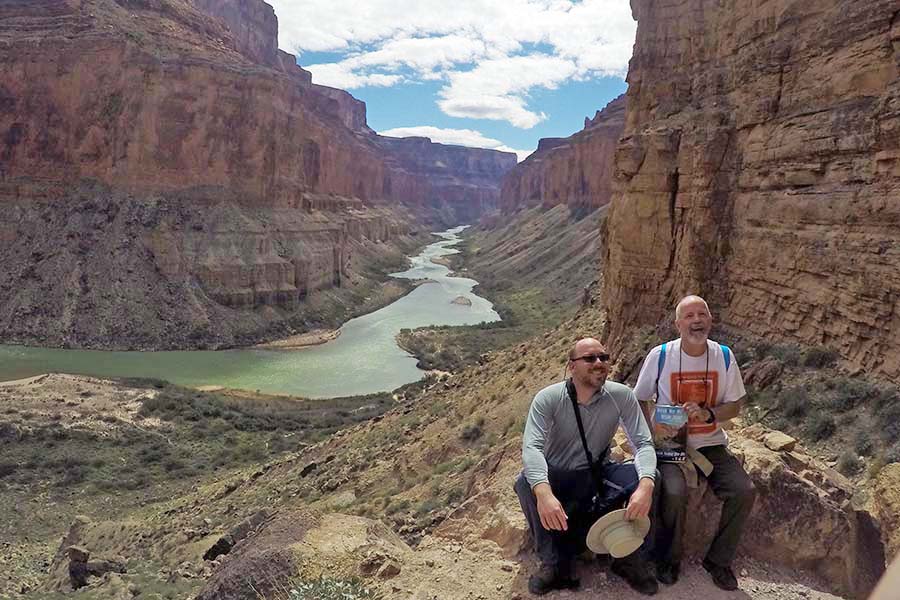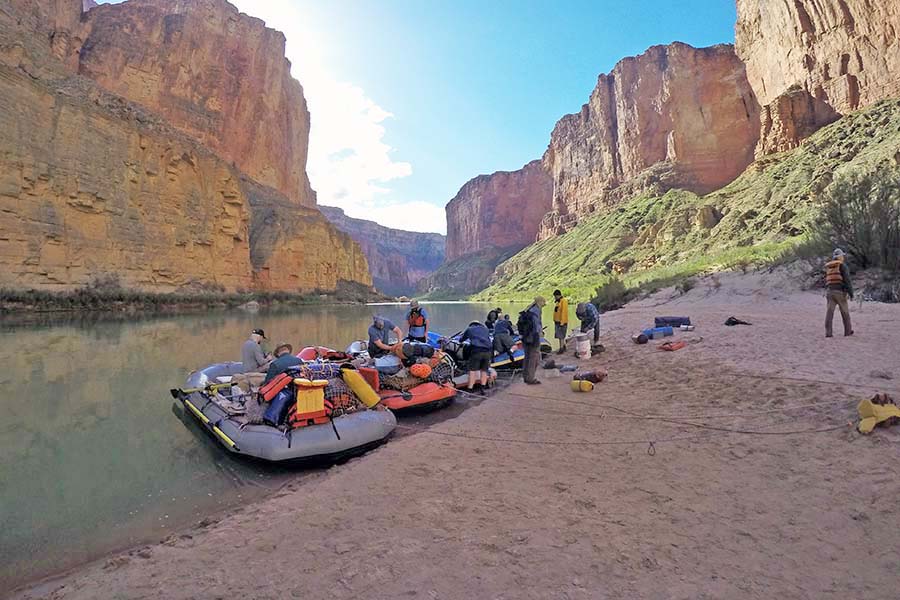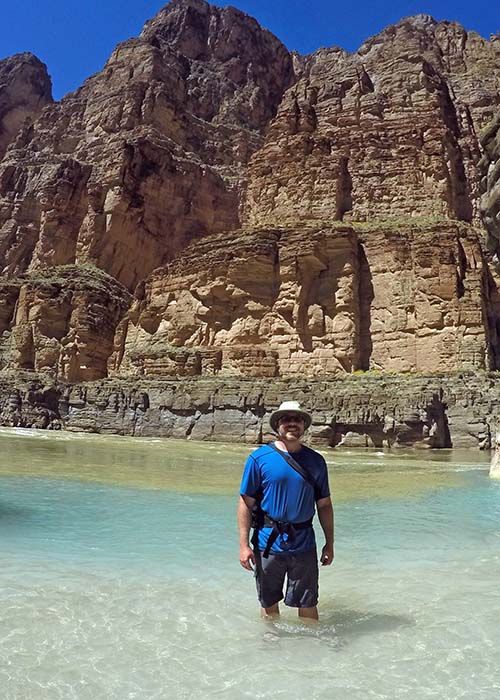You’re accessing archived content
This is archived content from the UIT website. Information may be outdated, and links may no longer function. Please contact stratcomm@it.utah.edu if you have any questions about archived content.
Going with the flow: Moore spends 23 days rafting Colorado River

UIT's Chris Moore, left, and his father, Paul, take a break during a 23-day Grand Canyon rafting trip this spring.
As you descend the Colorado River, the canyon walls rise higher and higher, thousands of feet into the sky.
This dramatic landscape laid the backdrop for an epic 23-day rafting trip this past March for UIT's Chris Moore and 14 fellow adventurers. Blue-green waters carried them 279 miles down the mighty river – bypassing fern-fringed narrows, 180-degree bends, and rocky rapids. Five rafts were launched out of Lee's Ferry near the Utah–Arizona border on March 23, and taken out at Pearce Ferry at the eastern edge of Lake Mead on April 15.
"It was a lot of fun," Moore said. "You’re going through wonderful places and there’s so much to see."
The trip had everything but cell reception. This was satellite phone territory, besides the couple bars his father Paul managed on the second night, and that's appealing to a guy like Moore, technical support analyst in UIT’s Campus Help Desk & Operations (you may recognize his voice from help desk recordings). Untethered from a headset and deprived of constant connectivity, he had to rely on a stack of maps, "reading" the river, and verbal communication.

The 279-mile route, from Lee's Ferry on the Utah–Arizona border to Pearce Ferry at the eastern edge of Lake Mead.
Moore was introduced to whitewater rafting in his late teens on a family trip down a section of Snake River, departing from Jackson, Wyoming. He spent years traversing rivers in Utah and Idaho, graduating to all-day trips in the Colorado River's Westwater Canyon with his dad, family friends and associates.
Moore likens multi-day rafting trips to car camping.
"Once on the river, you’ve got all your stuff in the boat – you carry everything you need and set up camp at various destinations," he said.
The spring trip, Moore's first through the Grand Canyon, was more than a year in the making. People planning self-guided river trips must first obtain permit approvals, which are handled by a National Park Service lottery system. On the day of the launch, park rangers met up with Moore and company to look over the permits and check gear, but once out on the water, that’s where the contact ended.

The 14 people in Moore's party traveled on five rafts.
"These are some of the most remote areas you can get to," Moore said. "That's why supplies and provisioning are so critical. In wilderness areas like the Grand Canyon, the only way to get re-supplied is hiking down from the rim, or if there’s an emergency, they pick you up by helicopter. But for most trips, once you start, you’re going through the whole trip. There’s not a lot of opportunity to get out."
Of course, at some point each day, they got out and set up camp. Where some rivers boast pre-registered campsites, on the Colorado, campsites aren't generally picked out beforehand. Moore said they had a rough idea of where they wanted to take out but river travel is largely contingent on when they departed that day and the behavior of the river.
It makes sense that punctuality isn't a hallmark of oar-powered river travel. A river may rush, but it’s never truly in a hurry.
“This is nature, it’s unpredictable,” Moore said. “It’s not incredibly dangerous, but there’s certainly some level of risk.”
Mitigating risks are the rafting hobbyists who typically join Moore on trips of this scale.
"They've done it for a long time, some for decades, so they have the gear and expertise," he said. "People are pretty laid back, everyone's there to have a good time, and having a good, reliable group helps keep everybody safe."
The raft that Moore crewed belongs to his dad, who purchased it 10 years ago for a similar Grand Canyon rafting trip. These are oar-rigged boats, meaning one person is designated to row, while another captains the boat, navigating it through tricky sections. Maneuverability can be a challenge, especially on a long trip like this last one, where the rafts were weighed down by 3,000 pounds of gear.
"It was an awful lot of work going through some of the sections," Moore said, which you can see in the helmet cam video taken by a rafting companion, shown at right.
Strength is helpful but not as important as the ability to read the river, that is, predicting the bends and rocks before they happen.
"Good navigation is being able to say, 'I’m here, but there are obstacles there,' and thinking ahead to make sure the boat is in a certain place at a certain time," Moore said. "It's almost a Zen thing where you row once, and a minute later the boat is in the right place to go around a rock."

Cove break: Moore out of the raft and
getting his feet wet.
Fortunately, they were hardly the first people to navigate the Colorado River. Since John Wesley Powell mapped out much of it on his Geographic Expedition of 1869, in wooden boats no less, a cottage industry of guided river tours has scaled to dozens of commercial outfitters, shepherding tourists on everything from oared and paddled rafts to large motorized rafts. The upside to this demand are the number of commercially produced river maps available to self-guided groups – some with detailed description of rapids, others noting all variety of side hikes.
One of the first questions Moore often gets from people new to river rafting is: Once you get to Point B, how do you get back to Point A?
It's a good question. The answer? Shuttle services can be hired to bring all your Point A stuff to your destination, as in, drivers take vehicles from where you put in to where you take out. Sounds simple, but it can be complicated in rugged areas lacking through roads.
"Sometimes, the road routes around tend to be very long," Moore said.
In addition to the Grand Canyon, Moore recently returned from a June rafting trip on the Snake River in Wyoming.
“If you like being out on the water, we're pretty fortunate to live where we do," he said. "There are definitely a lot of different places you can go."
Node 4
Our monthly newsletter includes news from UIT and other campus/ University of Utah Health IT organizations, features about UIT employees, IT governance news, and various announcements and updates.
